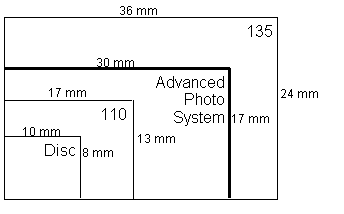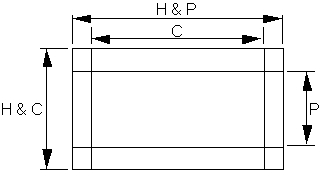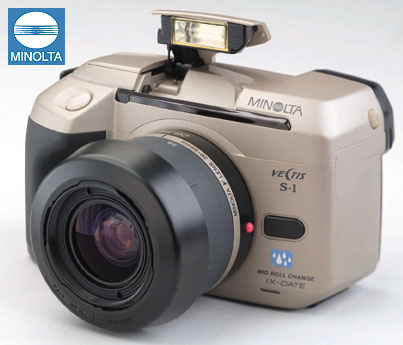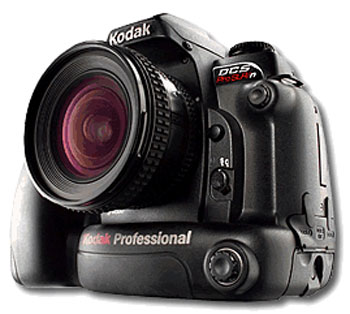The Digital Sensor: A Guide to Understanding Digital Cameras
by Wesley Fink on April 21, 2008 1:00 AM EST- Posted in
- Digital Camera
Why All these Different Sensor Sizes?
35mm first appeared on the scene in the 1930s and the film format simply took 35mm motion picture film and spooled it into a light-tight canister. By the 1960s, with point-and-shoot and developments in SLR technology, 35mm had become king of the film formats. Even as film manufacturers tried to introduce other film formats, 35mm continued to grow and prosper.
The SLR evolved in 35mm space and the world appeared orderly on the surface, but the only real constant was the size of the film. It was 35mm, but SLR manufacturers each championed their own lens mount and their exclusive lens line for their SLR film cameras. The primary advantage of the SLR was the ability to look through a wide variety of interchangeable lenses, and to accurately focus, meter, and later auto-focus through the viewing lens. As in today's digital SLR market, each manufacturer had their own lens mount, and lenses developed for one mount would not fit and work on others, i.e. a Nikon lens would not fit or work on a Canon camera.
APS (Advanced Photo System)
With the very early developments in digital photography, Kodak, Fuji, and others saw the handwriting on the wall for film photography. One of the ongoing complaints about 35mm film, however, has been that the 2:3 image format required image loss in almost every standard print size. Neither 8x10 nor 5x7 is a 2:3 ratio and both required cropping of the 35mm negative.

In 1996 a new APS (Advanced Photo System) initiative by Kodak, Fujifilm, Minolta, Nikon, Canon, and others was introduced to save film by standardizing on new ratios and adding new "computer-like" data storage capabilities in the taking and processing of film images. APS included a new film size - 30.2mm x 16.7mm - that could be printed full-frame (H or HDTV format), or use standard crops of 25.1mm x 16.7mm (C or Classic 2:3 format) or 9.5mm x 30.2mm (P or Panorama). Actually, the image size that was always shot was the 30.2mm x 16.7mm, and the other sizes were just standard crops.

The industry was confident they could sell APS, which in the most common C view was only about 55% of the already small 35mm size. Some manufacturers like Minolta developed new APS lens lines with smaller cameras and lenses, and Canon and Nikon developed APS camera bodies that could mount their regular lenses - and a few custom APS lenses.

In the end, APS failed in the film market. Industry pundits generally say APS failed because the negative was just too small, but it is more likely that it failed because it was just too late. Digital was on the near horizon, and many photographers did embrace smaller digital sensors while they rejected the smaller APS film format.
APS film is not that important in our discussion of digital photography, but the APS standard is important because it was also a standard for digital development. At the time of the APS initiatives, it seemed reasonable to aim for development of digital sensors for that same APS format, so lenses for both systems were interchangeable.
Most in the industry aimed for the APS C size sensor, which would be about 16.7mm x 25.1mm - the same ratio (2:3) as the classic 35mm format. Most manufacturers, burned by bad decisions in the APS film debacle, decided to keep their existing 35mm mounts, so their existing 35mm lenses could be used. They hedged their bets. This pleased current 35mm system owners, and camera makers could see if the new digital SLRs took hold. Once they were satisfied there was a market for digital SLR cameras, they could develop new lenses with a smaller image circle.

Canon and Nikon worked with Kodak in the early digital years to use their best film bodies with the current state-of-the-art Kodak sensors. These early DSLR cameras were incredibly expensive with massive power requirements and pro only. This development line culminated in the full-frame Kodak DCS Pro SLR/n and SLR/c. Those two cameras were the end of Kodak digital SLR cameras, although the company is still very active in the development and manufacture of digital imaging sensors and compact digital cameras.
Camera manufacturers introduced digital SLR products that revolved around the strength of their SLR business, the sensor capabilities they brought to manufacturing, and the relationships they had with other sensor manufacturers. Most of today's consumer DSLR cameras are based on sensors approximately APS C size, but they vary from the Olympus 4/3 sensor at 225mm² to the full-frame 35mm size with an area of 864mm².
Discussion of sensor size always tends to generate passionate discussion of the advantages of one manufacturer's sensor format over others, but please keep sensor sizes in perspective. The smallest 4/3 sensor still has 5.2x greater sensor area than the 43mm² sensor used in the 12MP Canon G9. The 4/3 sensor is 9x greater area than the common 1/2.5" compact sensor with an area of 25mm². Differences in digital SLR sensor size do matter, but they are very small compared to the difference in area between compact point and shoot digital sensors and today's digital SLR camera sensors.










72 Comments
View All Comments
Midwayman - Friday, April 25, 2008 - link
I'm happy. I'll won't argue that it's not a variant, but its design is different enough to warrant a mention. Even for such an old sensor, it still produces a dynamic range that exceeds notables such as the 5d, etc. I know I love my Super CCD based f30.http://www.imaging-resource.com/PRODS/S3/S3PA6.HTM">http://www.imaging-resource.com/PRODS/S3/S3PA6.HTM
Has a reasonably good discussion on the super ccd for those interested.
haplo602 - Thursday, April 24, 2008 - link
http://www.fujifilm.com/products/digital_cameras/s...">http://www.fujifilm.com/products/digital_cameras/s...ElFenix - Wednesday, April 23, 2008 - link
http://gizmodo.com/383170/giz-explains-digital-cam...">http://gizmodo.com/383170/giz-explains-digital-cam...Ajax9000 - Monday, April 21, 2008 - link
Two criticisms of the article.1> The sensor size discussion was rather muddled, with half of the information on p.4 duplicating the info on p.2
2> Yes, full-frame is really nice to aspire to, but the problem of full-frame sensor cost was not mentioned. IC lithographic machines ("steppers") cannot image a FF sensor in a single pass, making the production time cost 2-3x greater than smaller sensors (APS-H is the biggest that can be done as single pass). Worse, the large size of the sensor compared to the wafer means that yields drop appreciably as the sensor size increases. All in all, FF sensors can be 10-20x more expensive than APS-C sensors, let alone 4/3, 1/1.8", etc.
See for example: p.68 in http://www.canon.com/technology/pdf/tech2008e.pdf">http://www.canon.com/technology/pdf/tech2008e.pdf and pp.11&12 in http://www.robgalbraith.com/public_files/Canon_Ful...">http://www.robgalbraith.com/public_files/Canon_Ful...
To quote Canon (2nd ref): "Regardless of future technological developments, cameras with full-frame sensors will always cost much more than cameras with smaller sensors."
ElFenix - Wednesday, April 23, 2008 - link
steppers used to not be able to make 35 mm sensors in one pass. as canon and nikon are two of the bigger stepper manufacturers, guess what has likely happened? and both of them are smart enough to not announce that they've made the larger stepper, so as to make more profit than the other.Wesley Fink - Tuesday, April 22, 2008 - link
Page 2 emphasized the huge size difference between compact point-and-shoot-sensors and DSLR sensors as classes of sensors. Page 3 then explored how all the DSLR sensor sizes evolved within that class, and page 4 detailed the current variations in sensor size within the DSLR class. I appreciate your comments, but can you provide some specifics on what needs to be changed?The full-frame sensor does indeed cost more, which was mentioned a number of times in the article. However, prices are still dropping for the full-frame sensor as evidenced by the fact that the street price of the Canon 5D is now around $2000.
Ajax9000 - Wednesday, April 23, 2008 - link
Some suggested edits:Page 1
[Delete http://images.anandtech.com/reviews/cameras/2008/s...">http://images.anandtech.com/reviews/cameras/2008/s... ]
Page 2
Sensors Today
Table: Sensor Comparison
Type Width (mm) Height (mm) Area (mm^2) Percent Full Frame Crop Factor (Lens Multiplier)
1/3.6" 4 3 12.00 1.39 8.49
1/3.2" 4.54 3.42 15.53 1.80 7.46
1/3" 4.8 3.6 17.28 2.00 7.07
1/2.7" 5.37 4.03 21.64 2.50 6.32
1/2.5" 5.76 4.29 24.71 2.86 5.91
1/2" 6.4 4.8 30.72 3.56 5.30
1/1.8" 7.18 5.32 38.20 4.42 4.76
1/1.7" 7.6 5.7 43.32 5.01 4.47
2/3" 8.8 6.6 58.08 6.72 3.86
1" 12.8 9.6 122.88 14.22 2.65
4/3" 18 13.5 243.00 28.13 1.89
"APS C" 23.7 15.7 372.09 43.07 1.52
APS C 25.1 16.7 419.17 48.52 1.44
APS H 30.2 16.7 504.34 58.37 1.31
35mm film 36 24 864 100 1.00
In the above Table we can see the range of sensor sizes now available. However, the majority of Compact or Point and Shoot cameras today still generally use a 1/2.3" to 1/2.5" sensor. A few top-of-the-line compact cameras, like the Canon G9, feature a 1/1.8" to 1/1.7" sensor; and the very best compact cameras have sensors around the 1/3" to 1/2" range. In contrast, the sensor sizes for today's DSLR cameras are in the range of 4/3" and APS C. A few top pro cameras now sport 35mm-size sensors and are referred to as full frame.
The APS C to 4/3 sensors of the bulk of today's digital SLR cameras are huge by comparison to those found in mainstream Compact or Point and Shoot cameras. To see the difference in the relative size of P&S sensors and DSLR sensors, look at the graphic below.
http://images.anandtech.com/reviews/cameras/2008/s...">http://images.anandtech.com/reviews/cameras/2008/s...
[Delete http://images.anandtech.com/reviews/cameras/2008/s...">http://images.anandtech.com/reviews/cameras/2008/s... ]
Why Does Sensor Size Matter?
...
Page 3
Why All these Different Sensor Sizes?
35mm first appeared on the scene in the 1930s, using an image frame of around 24x16mm. 35mm still film simply took 35mm motion picture film and spooled it into a light-tight canister, turned the spool direction by 90 degrees, and used double the frame size. (In fact, some early 35mm still cameras were referred to as "double-frame" cameras.) By the 1960s, with point-and-shoot and developments in SLR technology, 35mm had become king of the film formats. Even as film manufacturers tried to introduce other film formats, 35mm continued to grow and prosper.
...
... Actually, the image size that was always shot was the 30.2mm x 16.7mm, and the other sizes were just standard crops. The 24mm by 16mm APS C format is approximately the same size as the 1/2 frame 35mm championed by Olympus in the film era.
Page 4
Sensor Size and Multipliers
[Delete http://images.anandtech.com/reviews/cameras/2008/s...">http://images.anandtech.com/reviews/cameras/2008/s... ]
...
More recently, Canon has championed the full-frame sensor in their pro cameras and in their pro/amateur 5D model. Larger sensor manufacturing cost has dropped as digital sensors have evolved and it now appears likely the APS-H (1.3X lens multiplier) will eventually drop from the Canon line. Since no lenses depend on that image circle all current Canon full-frame lenses, such as those used with the APS-H cameras, will remain usable on the full-frame sensor pro models that will replace them.
The developing push for full-frame at the top of the current DSLR market is a move to a sensor that is a bit more than double the size of today's APS C sensors. And there is a significant problem with this -- the full-frame sensors are made using different process techniques to even APS H sized sensors, greatly increasing their relative costs. In short, the IC lithographic machines ("steppers") that make the sensors cannot image a full frame sensor in a single pass, making the production time cost 2-3x greater than smaller sensors (APS-H is the biggest that can be done as single pass). Worse, the large size of the sensor compared to the wafer means that yields drop appreciably as the sensor size increases. According to Canon USA, full frame sensors can be 10-20x more expensive than APS-C sensors.
(
As a comparison to computer components, most CPUs are less than 300mm^2. The very large and expensive G80 and R600 GPUs are about 480mm^2 and 420mm^2 respectively. Unlike CPUs and GPUs that can increase performance through a die-shrink, APS, 4/3, and full frame sensors have a fixed die size -- so Moores Law doesn't apply.
http://pc.watch.impress.co.jp/docs/2007/0423/kaiga...">http://pc.watch.impress.co.jp/docs/2007/0423/kaiga...
http://pc.watch.impress.co.jp/docs/2007/0705/kaiga...">http://pc.watch.impress.co.jp/docs/2007/0705/kaiga...
)
It is not surprising then that dSLRs mostly use APS C and 4/3 sensors.
Nikon, Pentax, and Minolta all had significant success in the 35mm film market, so all three had a vested interest in preserving their 35mm lens mount and keeping their current 35mm system users happy. However, none of these three had the resources to develop and manufacture their own sensors, so they partnered with sensor manufacturers to produce digital SLR cameras. Of course, these manufacturers were mostly making APS C, 4/3, and smaller sensors. In recent years that partner has been Sony, so all three manufacturers have basically adopted a 23.6x15.7mm sensor with a 1.5X lens multiplier.
...
CSMR - Monday, April 21, 2008 - link
I am not an expert but it seems to me the most important point has been missed in this article: depth of field. Larger sensors allow for greater depth of field with the same lens. There is a lot of discussion of "image quality" (resolution, shutter speed, sensitivity) but depth of field alters what the image is, which is more important.Wesley Fink - Monday, April 21, 2008 - link
In the interest of keeping the article somewhat basic and a digestible size we did not include a discussion of the depth of field variations with compact sensors compared to DSLR sensors.This IS an important concern for creative use of depth of field since the DOF is much greater with the smaller sensor than with the DSLR sensor. Not everyone would agree that a shallower depth of field on a DSLR is more desirable. It certainly might be in a portrait, but not in a sweeping landscape shot. The desired DOF depends on what you are shooting.
melgross - Tuesday, April 22, 2008 - link
This is a very complex subject for many people. It's not just the sensor size that determines depth of field.But, we also have perspective to worry about.